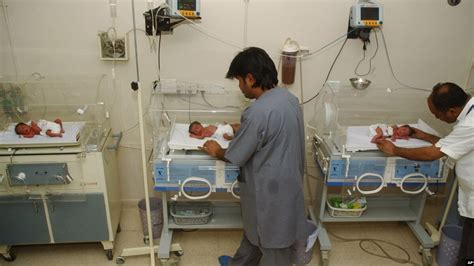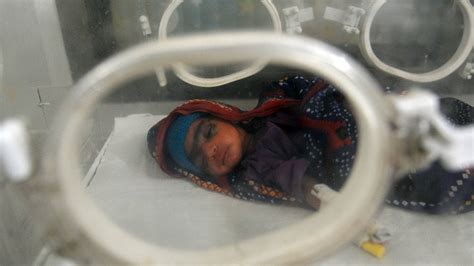Sajid Ali, a resident of Kisuki Road, Hafizabad, is engaged in the leather industry. His sister, Tahira Yasmeen, experienced a dissolution of her marriage nine years prior, at a time when she was raising two children.
Ali recounts an incident from September 2017 when his niece, Mehreen Rani, approximately five years of age, manifested symptoms of a significant fever one evening. Without delay, Ali transported her to a proximate hospital, where she was promptly admitted and treatment commenced.
However, after two days of ongoing treatment with no visible improvement in her condition, the attending physician at the private medical facility recommended a transfer to the Lahore Children’s Hospital for advanced care. Acting swiftly on this advice, Ali brought her to the emergency department of the aforementioned hospital. Upon arrival, the emergency duty physician conducted a thorough examination and subsequently admitted her for further treatment.
Despite the medical interventions, the child’s condition deteriorated, with an escalation in symptoms such as a severe sore throat and respiratory difficulties. Tragically, after three days of intensive care, she passed away.
Medical professionals determined that the cause of the girl’s demise was a throat infection, attributed likely to adverse environmental conditions. Given her compromised immune system, she was particularly vulnerable and ultimately unable to recover.
Sajid Ali reports that his sister was profoundly affected by this abrupt loss, becoming exceedingly vigilant concerning her son’s well-being and imposing restrictions on his social interactions.
Ali further mentions that, in the year of his niece’s passing, the community witnessed the deaths of two additional children from the same ailment. This series of unfortunate events led to heightened concern among residents of the surrounding areas. Despite financial constraints, they implemented measures to safeguard their children’s health, focusing on the quality of drinking water and food.
Hafizabad holds the highest child mortality rate within the province, as revealed by findings from the Multiple Indicator Cluster Survey (MICS). This survey is part of a program developed by the United Nations Children’s Fund (UNICEF) and is conducted in various countries to monitor critical health indicators.
The survey carried out between 2017 and 2018 with the collaboration of the Government of Pakistan, the World Health Organization, and UNICEF, specifically in the Punjab province, highlighted that Hafizabad District surpasses all other districts in Punjab in terms of child mortality rates.
The data indicates that in Hafizabad, 109 out of every 1,000 children do not survive until their fifth birthday. This statistic is notably higher when compared to the provincial average of 69 deaths per 1,000 children, as corroborated by the district profile report released by the Punjab government in 2022. Consequently, Hafizabad is distinguished as the district with the highest rate of child mortality among the 36 districts of Punjab.
The report elucidates that in Hafizabad, the mortality rate is not confined to children under five years but extends to newborns as well, with 59 out of 1,000 newborns (less than one-month-old) and 97 out of every 1,000 children succumbing to various causes. This contrasts with the wider province of Punjab, where the rates are 41 and 60, respectively.
Medical experts attribute the elevated child mortality rates to a combination of poverty, inadequate health facilities, adverse climatic conditions, and substandard nutritional intake.
The Gender Parity Report issued by the Punjab government two years prior positions Hafizabad at the lowest rank among the 36 districts in Punjab concerning the availability of health services. The report indicates that there are a total of 61 health centers or medical facilities in the district, including Basic Health Units (BHUs), Rural Health Centers (RHCs), tehsil and district headquarters hospitals, and government dispensaries.
Furthermore, the number of health centers dedicated to child health and nutrition during and post-maternity stands at 22, which is the second lowest in the district following Khushab.
Dr. Bilal Rafiq Malik, Assistant Professor of Medicine at King Edward Medical University, highlights that the susceptibility of young children to mortality stems from a myriad of factors. These include the introduction of pathogens through consumption and inhalation, preterm birth, inadequate maternal nutrition during pregnancy, insufficient spacing between births, and a lack of proper nutrition for the child.
The query regarding the safety of vaccines has garnered attention in light of observations from a Health Department official in Hafizabad, who attributes the district’s elevated child mortality rate, in part, to immunization practices. This perspective is supported by the case of Khurram Shahzad, a laborer from Jalalpur Bhatan, whose three-month-old son, Ali Sher, exhibited fever symptoms following vaccination on April 14, 2022, and subsequently passed away the next day. An investigation by the Hafizabad Health Department culminated in a report attributing the child’s death to the vaccination received.

However, Dr. Jameel, the District Health Officer of Sheikhupura, offers a counterpoint, emphasizing the critical role of immunizations in safeguarding children against various diseases. He acknowledges that while there are isolated instances where vaccination has been linked to adverse outcomes, such occurrences are exceedingly rare. Dr. Jameel further elaborates that the use of a single vaccine vial for up to 20 children does not imply a direct correlation between vaccination and the unfortunate demise of a child. Factors such as pre-existing illness, compromised immunity, or potential allergies could precipitate a reaction to the vaccine, rather than the vaccine itself being inherently harmful.
In a conversation, Mohammad Rauf, the supervisor of health visitors in the Sheikhupura district, adjacent to Hafizabad, conveyed that vaccination personnel undergo comprehensive training to mitigate potential adverse effects associated with vaccinations.
Rauf highlighted the importance of adherence to protocols, noting that lapses in staff diligence could lead to fatal outcomes. He cited instances from the previous year where several children in Toba Tek Singh and Bahawalpur succumbed following measles vaccinations. Subsequent investigations by the Punjab Health Department revealed that the fatalities were due to the improper preparation of injections, where drip water was used instead of the appropriate diluent, triggering adverse reactions in the children.
Regarding child mortality rates, the United Nations agency UNICEF’s 2020 report indicates that in Pakistan, 44 out of 1,000 children die at birth, and 75 out of 1,000 children do not survive to the age of five. The overall infant mortality rate in Pakistan was documented at 69.3 per 1,000 live births in 2018, showing a reduction from 80.5 in 2013. These figures are notably higher in comparison to war-affected and economically challenged regions such as Afghanistan, with a rate of 62.3, and other neighboring countries like India at 61, Nepal at 48, and Bangladesh at 46.
The United Nations Children’s Fund (UNICEF) report highlights that children aged between one and four years constitute 13% of Pakistan’s total population, yet nearly half of the country’s child population is afflicted with deficiencies in essential nutrients such as vitamin A, vitamin D, zinc, calcium, and minerals.
The report further details that 51.5% of Pakistani children are deficient in vitamin A, with 12.1% experiencing severe deficiency. Moreover, a significant 62.7% of children under five years old are found to be deficient in vitamin D.
Medical professionals emphasize the critical health implications of these deficiencies: a lack of vitamin A primarily impairs vision, while insufficient vitamin D intake detrimentally affects bone health.
The report also indicates a concerning prevalence of anemia in 53.7% of children, noting a higher incidence among children residing in rural areas compared to their urban counterparts. Contributory factors to this disparity include the early marriage of women, and the adverse health effects of repeated pregnancies, which not only impact the mother’s health but also result in children who are at an increased risk of developing various diseases and facing mortality due to compromised vision.
Furthermore, the report identifies pneumonia, diarrhea, measles, malaria, hemolytic diseases, maternal infections, and malnutrition as prominent causes of mortality among children under five years of age.
UNICEF’s findings underscore the varying conditions across Pakistan’s provinces in terms of child mortality rates, pointing to a complex web of nutritional, environmental, and healthcare challenges that necessitate comprehensive and targeted interventions.
The Pakistan Demographic Health Survey (PDHS) reveals a discernible disparity in child mortality rates between rural and urban areas within Pakistan. Specifically, the mortality rate in rural areas stands at 83 per 1,000, in stark contrast to the urban rate of 56 per 1,000. This discrepancy is largely attributed to the pronounced deficiency of healthcare facilities in rural locales compared to urban centers.
The significance of timely immunizations in curbing child mortality cannot be overstated. Dr. Bilal Rafiq Malik, an Assistant Professor at King Edward Medical University, emphasizes the critical role of both parents and the government in addressing this issue. He advocates for the prompt vaccination of children, noting that delays or omissions in vaccination schedules significantly elevate the risk of children succumbing to potentially fatal diseases.
Health experts concur that augmenting the health care system at the national level is imperative for reducing the child mortality rate. Furthermore, they suggest that educational initiatives targeting women from socio-economically lower and middle tiers should be prioritized by the government to enhance awareness about vital health practices.
In line with recommendations from the World Health Organization, it is advised that a developing nation such as Pakistan allocate a minimum of 86 dollars per capita annually towards health care expenditure to address these pressing health challenges effectively.
Current data indicates that the allocation towards the health sector from the national product amounts to approximately one percent, a critically low figure. The United Nations Children’s Fund (UNICEF) report underscores the direct correlation between the scarcity of medical amenities, inadequate nutrition, and persistently high child mortality rates, signaling an urgent need for enhanced investments in healthcare infrastructure.
Muhammad Rauf, a dedicated official within the Sheikhupura Health Department, provides insights into the upcoming Multiple Indicator Cluster Survey (MICS) scheduled for 2017 and 2018, which is set to be conducted across Punjab in the year 2024. A pivotal training session was orchestrated by the Punjab Health Department officials in Lahore on February 17, 2024, drawing participation from representatives of all districts within Punjab. This session was aimed at reinforcing the importance of meeting immunization coverage targets set forth by the Punjab Health Department across all districts.
Dr. Umar, the CEO of the District Health Authority in Hafizabad, in conversation, highlighted the concerted efforts being made to attain set objectives during various preventative campaigns, including those for immunization and polio eradication throughout the district. He detailed the proactive measures being undertaken by health department teams, utilizing all available resources to administer immunizations, vitamins, and polio drops directly to children at their homes, thereby aiming to substantially enhance their immunity.
Dr. Umar notes instances from specific regions where parents exhibit reluctance towards administering polio vaccinations and other immunizations to their children. To address such challenges promptly, the establishment of a specialized unit known as the “High-Risk Mobile Population” (HRMP) has been undertaken. This team is tasked with compiling reports for submission to senior officials, and their efforts are occasionally supported by law enforcement to ensure compliance.
There have been recorded incidents where parents not only failed to provide the requisite immunization documentation to the health department’s surveillance teams but also displayed hostility towards health personnel. In response, the introduction of mandatory immunization record cards has been implemented to facilitate the registration of children’s names, with provisions for legal action if necessary. The overarching objective is to heighten parental awareness regarding the critical importance of vaccinations.
Dr. Umar further mentions the health department’s initiatives aimed at educating the illiterate populace, which have yielded significant outcomes. Notably, the Hafizabad district has surpassed 99% of its objectives in the polio and vitamin campaigns scheduled for March 2024.
Health Department officials in Hafizabad are optimistic that the 2024 survey will demonstrate a notable decline in the mortality rate among children under five years of age, compared to previous records.
